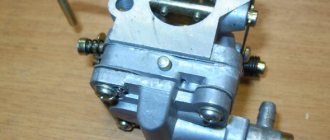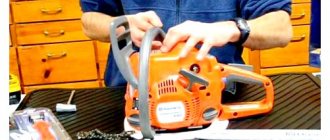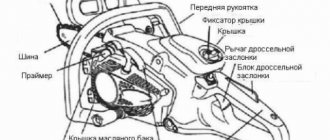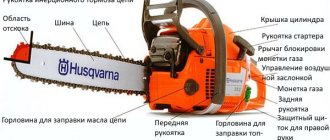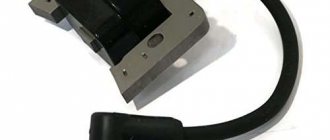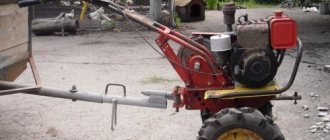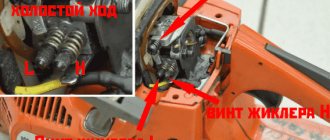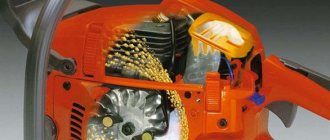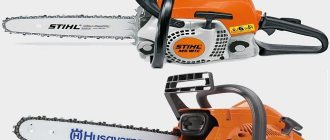Common malfunctions of the Husqvarna 137 chainsaw
A chainsaw is irreplaceable in the owner’s home. This tool is in demand and popular, as it helps to make the work of a forester or gardener easier. Husqvarna is a popular company that has a long history of creating high-quality tools and equipment for all your gardening needs.
More often, people buy a Husqvarna 137 chainsaw for use in personal enterprises, households or forestry. The presented products have proven themselves well in large-scale industrial construction.
The manufacturer offers its customers a wide and varied selection of products , but its specialization is the development of chainsaws. The Husqvarna 137 saw is a more successful and high-quality model. It is comfortable to use, lightweight and economical. However, it is powerful enough to cope with large volumes of work.
Possible malfunctions of the Husqvarna 137 chainsaw
When a person may encounter some breakdowns of the Husqvarna 137 chainsaw , which you need to remove. Now there is a huge selection of workshops where specialists repair and maintain equipment. However, you will have to pay a considerable amount for this work.
Repair of the Husqvarna 137 saw in makeshift conditions without calling on specialists. When the breakdown is minor, it makes no sense to go to the workshop and waste your time. There is a list of more common problems that the owner of such equipment may encounter. Therefore, it is purposeful to learn everything about them, so that you are always fully armed.
How to change the sprocket?
If you need to replace the sprocket on a Husqvarna 137 chainsaw, you will need to perform the following algorithm:
- Open the side cover giving access to the tire and sprocket.
- After loosening the chain, you need to remove the tire.
- Once the sprocket is free, unscrew the spark plug to gain access to the engine piston.
- You need to rotate the sprocket manually.
- The piston is brought almost to the highest point of the channel.
- The resulting hole must be filled as tightly as possible using a soft candle cord. This will block the movement of the piston.
- To unscrew the sprocket, use an open-end wrench.
Prerequisites for failure of the accounting ignition system
Read:
If the Husqvarna saw has stopped working , then you mainly need to check the spark plug for functionality. This must be done very carefully using a specially designed hook. First, the wires are disconnected from the body of the floor, and look at the type of candle.
- If the spark plug is dry, then this means that fuel simply does not enter the main cylinder. Under such circumstances, the fault is not in the spark plug, so it can be safely screwed back in.
- When fuel splashes occur on this part, the main problem lies in the carburetor. This indicates that it was incorrectly adjusted or the start rule was violated.
Why does a chainsaw have trouble starting?
- fuel and air filters;
- reduced compression;
- carburetor adjustment;
- spark plug;
- ignition coil;
- gap between the ignition coil and the flywheel;
Let's look at each reason in more detail.
Fuel and air filter
Contamination of the main filter elements of a chainsaw negatively affects its operation.
For example, a dirty air filter will not provide enough air to the carburetor, which will affect the quality of the air-fuel mixture and normal engine starting. A dirty fuel filter will make it difficult or even cut off the flow of gasoline to the carburetor and make it impossible for the engine to operate.
Reduced compression
One of the common cases of difficult starting of a chainsaw is wear of the CPG (cylinder-piston group).
As you know, for a chainsaw to start normally, compression must be present in its engine. It is necessary for normal compression of the fuel mixture in the engine cylinder, and it also affects the operation of the fuel pump.
During the operation of the tool, the compression value drops and the chainsaw begins to have difficulty starting.
The reasons for the lack of compression or its decrease may be natural, because The engine wears out during operation. Problems can also be caused by a serious breakdown, for example, a scuffed CPG, or a broken piston ring.
A sign of low compression is weak starter resistance when starting. With reduced compression, a decrease in the power of the chainsaw is observed, which negatively affects its performance. The problem is eliminated by replacing the piston rings, or the entire CPG.
Carburetor adjustment
Incorrect carburetor adjustment will cause the chainsaw to not develop full power. It will be difficult to start, or not start at all. Carburetor settings directly affect the quality of the air-fuel mixture, which is necessary for normal starting and further operation of the engine.
If the carburetor is incorrectly adjusted, there will be more or less gasoline in the fuel-air mixture than required, and the mixture will not ignite even with normal sparking.
Excess gasoline in the mixture is usually called overflow. A characteristic sign of overflow is a wet spark plug, after several unsuccessful attempts to start the chainsaw.
Spark plug
The spark plug is one of the main elements of the ignition system. A spark is formed at its electrodes, and if this element fails, starting will be difficult or not possible at all.
The spark plug may fail completely, or work intermittently or produce a weak spark. Checking the spark plug is quite simple; to do this, you need to unscrew it from the engine, attach it to the cap of the high-voltage wire and, placing it on the cylinder, pull the starter. If the spark plug is in order, the spark will be powerful with a bluish tint. A weak spark with a reddish tint is a sign of a problem. A defective spark plug needs to be replaced.
Ignition coil
The reason that a new chainsaw does not start, or starts poorly, may be the ignition coil. Modern chainsaws are equipped with electronic ignition coils. This part cannot be repaired, and, as a rule, if there is a defect, it is completely replaced.
Gap between ignition coil and flywheel
An incorrectly set gap between the flywheel and the ignition coil contacts affects the quality of spark formation, which in turn is responsible for normal starting and stable operation of the engine.
Why does gasoline not flow into the carburetor, Husgvarna 137? (Solving the problem).
Not
reason
the chainsaw starts
The MAX 3216
chainsaw no
signs of life. The cause of the problem has been found.
To eliminate such a problem in a chainsaw, it is recommended to carefully wipe the spark plug , turn off the fuel supply and turn on the starter. This procedure is performed to thoroughly ventilate the combustion chamber and remove excess fuel. After that, the spark plug is mounted in its original place and the Husqvarna 137 chainsaw is started.
When a candle is covered with heavy carbon deposits, this indicates the use of bad oil. In order for the chainsaw to serve for a long time, you need to use only tested and certified lubricants. When users incorrectly calculate the ratio of oil and gasoline, they also set inaccurate adjustment of the carburetor.
Under such circumstances, it is recommended to pay attention to the presence of a spark during startup . For this purpose, an ignition cable is installed on your spark plug, the cylinder and nut are connected. Now you can start the chainsaw starter and then a spark appears. If it is completely absent, then you should replace the old candle with a new one. There are times when users come to find a faulty high-voltage drive or fix a connection problem.
The chainsaw does not slow down - how to find and fix the problem?
The most common cause of this frequent failure is an incorrectly adjusted damper. It is necessary to suck in the air that the carburetor requires to enrich the fuel mixture with air. To adjust the throttle, you need to adjust the carburetor
In this case, special attention should be paid to the operation of the power unit at idle speed. You can check the operation of the engine in idle mode by paying attention to the state of the circuit immediately after starting the internal combustion engine
If it rotates, then the power unit will need to be adjusted.
Another cause of this typical malfunction is air leaks. If there is an air leak in one of the chainsaw mechanisms, the mixture will automatically become leaner, which will lead to a spontaneous increase in the speed of the chainsaw motor. In this case, the operator will need to carefully check the entire fuel system, including the carburetor, pipes, and working chambers of the unit.
In some cases, the chainsaw does not slow down due to a jammed accelerator cable. In this case, the power unit will independently gain speed to the maximum immediately after it is started. Disassembling the gas handle and inspecting the entire gas supply mechanism will help solve the problem. The jammed cable will need to be adjusted or completely replaced.
Fuel supply system
Read:
If chainsaw is used incorrectly, fuel does not enter the main cylinder. This malfunction appears for several reasons:
- dirty saw fuel filter;
- viscous chain oil;
- clogging of the special hole;
- dirty air filter.
To clean the fuel hose of a chainsaw, you need to carefully check the fuel supply. Experts advise changing the old hose every three months and getting a new part. When the air hose becomes dirty inside, allowing for accounting (software), and specifically, air does not flow into the carburetor. In most cases, this leads to disruption of the engine operation. The filter can be cleaned using ordinary water, but this function must be done very carefully.
The part is painstakingly dried and installed in its original place . The Husqvarna 137 chainsaw is sold with an instruction manual that describes in detail the technique for changing and cleaning hoses. If you do not follow the rules, then there is an option to worsen the situation.
A more common cause is a clogged channel or a violation of the integrity of the carburetor membrane. Here it is recommended to change the part and clean the channels. After a while, the chainsaw works without interruption.
The chainsaw itself is gaining momentum - how to solve the problem?
This malfunction most often indicates a violation of the operating mode of the fuel and other systems of the chainsaw. There is no single specific cause for this breakdown, since an arbitrary increase in the speed of a running motor can result in the formation of a defect in several different components at once.
The first thing the operator needs to do is inspect the fuel system components. Quite often, a chainsaw engine picks up speed on its own when the fuel supply settings in the standard carburetor are disrupted. In this case, you will need to remove the assembly, disassemble it and wash it with clean gasoline. After it dries, you need to install the carburetor back and make its settings.
Next you need to inspect the condition of the fuel filter. As a result of prolonged use of the chainsaw, it may become damaged. Because of this, the fuel will enter the cylinder unfiltered, with a large amount of impurities and small chips. This can damage the motor and cause it to seize. As a result, the chainsaw will randomly pick up speed immediately after starting its internal combustion engine.
The next step is for the operator to inspect the fuel pipes
They should sit in their seats and, most importantly, there should be no holes in their walls. If they appear, the fuel hose will need to be completely replaced.
Another reason for an arbitrary increase in speed is the jamming of the gas lever. If the operator frequently pressed it while wearing oil-stained gloves, grease particles could seep into the lever and stick to its surface. As a result, the lever itself will begin to stick to the walls of the housing, giving the command to the engine to gain speed. Disassembling and subsequent cleaning of the body and gas lever of the chainsaw will help solve this problem.
Muffler failure
If at low speeds the saw engine runs without interruption , and when they increase it stalls, then the problem is related to the muffler. This indicates a faulty spark arrester. Most likely, it is clogged with combustion waste. To perform cleaning, the muffler is first removed and disassembled. Next, the user painstakingly removes the resulting carbon deposits using detergent.
After this fact, experts advise drying the part with a hairdryer. At the end of all manipulations, the muffler is installed in its original place.
saw has a lightweight design , so a huge selection of defects can be removed at home. For this purpose, you should carefully study the breakdown and find out everything about the annotation. There are rules for disassembling and installing parts. The Husqvarna 137 saw is distinguished by its reliability and sufficient power. She copes with even the most complex tasks and does a large amount of work. Therefore, the presented chainsaw is widely used in large-scale industrial enterprises.
The small-sized chainsaw Husqvarna 137 belongs to the category of amateur equipment. The product is light, comfortable and compact. It is popular not only in households, but also among professional lumberjacks. The unit is in demand among builders, rescuers and foresters, as it is convenient for them to work in hard-to-reach places and in cramped conditions.
Chainsaw doesn't start well when cold
Violation of the sequence of actions when starting on a cold
If a new chainsaw does not start when cold, the reason may be the incorrect engine starting sequence. As a rule, each manufacturer, in the instructions for the chainsaw, indicates the procedure for starting the chainsaw when cold. Basically, it is similar for all two-stroke internal combustion engines that are installed on chainsaws, and represents the following procedure.
- Closing the air damper (necessary to enrich the fuel during startup).
- Fuel suction using a special primer for this (on some models of chainsaws, the primer is not provided by the design, and therefore this item is not available for them).
- Turning on the ignition (if you forget about this, you may mistakenly consider the tool to be faulty).
- Carry out several movements of the starter until the first “flash” of the engine (it is important not to miss this moment, otherwise it is possible to “flood” the engine).
- Set the air damper to the open position.
- Start the chainsaw engine.
Fuel problems
As in the case of difficult starting when hot, problems in the fuel system can also affect starting or the inability to start even when cold. Carburetor adjustment, contamination of the fuel filter and line are all reasons that cause starting difficulties.
Carry out diagnostics of the fuel system, this is the first thing you need when it is difficult to start when cold.
It is worth paying attention to the quality of the fuel, because... When using a mixture of gasoline and oil that contains a small amount of water, starting may be significantly difficult or impossible.
The mixture must be used fairly fresh, because... When gasoline diluted with oil is stored for more than a month, its properties are lost and it becomes difficult to start, both on a cold and hot engine. For this reason, gasoline may burn poorly.
Engine faults
CPG scuffing, ring sticking, CPG wear, air leaks through seals and gaskets, decreased compression, all these problems can make starting a chainsaw impossible or significantly complicate it. For example, if the CPG wear is not significant, the compression in the engine decreases. In this case, starting “cold” will be significantly difficult, or the saw may stop, the tool will start well.
It is quite difficult to accurately diagnose problems in the engine associated with problems in starting it, and it is better to contact a specialist in this field.
Scope of application
In industry, construction and private households, there is often a need for fast and high-quality cutting of wood. It is not always possible to do this with a hand or electric tool. A universal autonomous device is the Husqvarna 137 chainsaw, powered by an internal combustion engine.
The product is used for the following purposes:
- felling of trees, their shoots and bushes;
- clearing trunks of branches;
- firewood preparation;
- cutting timber, boards and logs into blanks;
- selection of grooves in lumber;
- adjusting wooden products to specified dimensions;
- wood carving, making crafts and sculptures;
- clearing debris in the forest;
- dismantling of wooden buildings.
Device
The product has a classic design for products of its class. Manufacturers have embodied simplicity and sufficiency in it.
Construction of the Husqvarna 137 chainsaw:
- frame;
- holding handles;
- mechanical starter;
- internal combustion engine;
- chain brake lever;
- tanks for oil and fuel mixture;
- throttle, gas and choke control levers;
- ignition button;
- muffler;
- sprocket tire;
- saw chain.
The fuel supply system and clutch are mounted inside the housing.
Carburetor
The unit is responsible for supplying a mixture of fuel and oil to the cylinder. The carburetor is equipped with a diaphragm and a special needle valve. These parts regulate the pressure in the system. The dosage of the supplied air is carried out by two dampers located on the diffuser chamber. One regulates the air volume when pressing the gas lever, and the second regulates the flow during a cold start of the tool. At this moment, the damper partially closes, and the enriched mixture enters the engine.
After mixing gasoline and oil, the fuel is supplied to the cylinder through an injector with a check valve. This is an important detail that prevents exhaust gases from entering the diffuser.
The chain for the Husqvarna 137 chainsaw is different:
- high strength;
- hardness;
- low vibration;
- wear resistance.
The drill links are equipped with chamfers that ensure high-quality cutting of hardwood.
Saw chain characteristics:
- link thickness - 1.3 mm;
- chain pitch - 3/8 inch;
- tire length - 40 cm;
- number of links - 56.
The product uses the “chisel with chamfer” technology. The tension is adjusted with a screwdriver by turning the adjusting screw. Sharpening is carried out with a round needle file with a diameter of 4 mm. An alternative is to use a sharpening machine or the services of specialists from a service center.
DIY carburetor repair
If, during a full diagnosis of the Husqvarna chainsaw, carburetor defects were discovered, some of them can be eliminated without contacting the Husqvarna AB service center. For example, you can do this yourself:
- change the gaskets under the covers of the main chamber and fuel pump;
- clean or replace the strainer;
- replace the diaphragm or needle valve of the main chamber;
- troubleshoot the fuel pump diaphragm.
Gaskets, diaphragms and a needle valve with a rocker arm can be found in the repair kit, which is available for each model of Husqvarna chainsaw carburetors.
Also, if you have some experience, you can try to restore a faulty injector valve, but you cannot guarantee a positive result when trying to restore an injector; if it malfunctions, manufacturers recommend replacing the carburetor completely.
Specifications
The parameters of the chainsaw compare favorably with those of similar light-class products.
Technical characteristics of the tool:
- type - gasoline, carburetor;
- engine power - 1.64 kW (2.2 hp);
- fuel tank volume - 0.41 l;
- oil tank volume - 0.20 l;
- engine volume - 36.3 cm³;
- number of links in the chain - 55;
- dimensions - 250x420x260 mm;
- noise level at full speed - 107 dB;
- weight without refueling - 4.9 kg;
- tire length - 40 cm;
Included with the chain saw are spare spark plugs and branded oil for lubricating the chain.
HUSQVARNA
Technical characteristics of Husqvarna 137
Cylinder volume — 36.3 cm3 Power — 1.6 kW (2.2 hp) Maximum recommended engine speed — 13000 rpm Fuel tank volume — 0.41 l Oil tank volume — 0.2 l Oil pump type — fixed flow Chain pitch — 0.325″ Recommended bar length - 13-15″ (33-38 cm) Sound level - 98dB(A) Noise level - 118 dB(A) Vibration, front / rear handle - 4.9m/s2 / 7.7m/s2 Weight (without tire and chains) - 4.6 kg
Vibration absorption and handles isolated from the motor.
Centrifugal air cleaning system for long filter cleaning intervals, trouble-free operation and reduced wear.
Curved front handle for better grip and natural working posture.
The narrow body, high center of gravity and flat bottom make the chainsaw extremely easy to use.
The double-action chain brake, right-hand guard and chain stop increase the safety of the saw.
Forged three-piece crankshaft designed to maximize service life and designed to withstand the harshest conditions.
Low noise level.
The low weight of all moving parts of the engine allows for fast acceleration.
Advantages and disadvantages
The Husqvarna 137 chainsaw, like any product, has pros and cons.
The advantages of the tool are as follows:
- high quality of manufacturing and fitting of parts together;
- use of wear-resistant materials, long service life;
- convenient design that provides balance when working;
- light weight of the product, use of durable polymer plastic;
- safety ensured by several safety devices;
- high performance;
- affordable cost of tools and consumables.
The product has practically no disadvantages. It is necessary to use high-quality fuels and lubricants and observe the proportions for preparing the fuel mixture. If this is not done, the tool will fail.
Repair features
Some problems with the Husqvarna 137 chainsaw can be fixed on your own. The service center is contacted only in cases where parts receive mechanical damage or wear out to a critical condition.
To carry out minor repairs or replace worn parts, use the repair tools that come with the product.
Work is carried out according to the table of possible breakdowns that may occur during operation.
So, if the saw does not start, the reason must be sought in the fuel supply system. When the tool stalls during operation, the repair of the Husqvarna 137 chainsaw may be limited to cleaning the muffler from carbon deposits.
How to adjust the carburetor
Primary adjustment of the carburetor is carried out at the manufacturer to standard fuel parameters based on operation in summer conditions. Changes in settings occur due to vibration during sawing wood or due to the use of a low-quality fuel mixture. Adjusting the chainsaw carburetor is performed in cases where the engine is unstable, does not start or stalls under load.
To repair a carburetor with your own hands, you need to have the following tools:
- screwdriver;
- wrench;
- thin wire.
Restoring the functionality of the product is carried out in the following ways:
- Cleaning clogged channels with wire.
- Adjusting the tension of the gas damper drive cable.
- Removing the faulty membrane and installing a new part.
- Sealing connections.
- Replacing the gasket.
After eliminating the malfunction, the device is fine-tuned by rotating the bolts L (crankshaft speed), T (idle speed) and H (fuel supply volume).
How to disassemble and reassemble a chainsaw
Disassembly of the product is carried out when:
- seasonal service;
- repair;
- planned replacement of worn parts and mechanisms.
The product is disassembled in the following sequence:
- Remove the handles.
- Loosen the housing bolts and remove the covers.
- Dismantle the tire and remove the chainsaw sprocket.
- Disconnect the starter.
- Unscrew the flywheel.
- Remove the clutch and oil pump drive.
- Disconnect the carburetor muffler and ignition coil.
- Disassemble the engine.
The unit is assembled in the reverse order.
When is carburetor adjustment necessary?
The reasons why adjustment of this unit will be needed can be listed for a very long time.
Among the main malfunctions are the following:
- Increase idle speed;
- The appearance of a large amount of smoke during operation;
- Deterioration of starting properties;
- Insufficient power of the tool when cutting.
This is not a complete list of all known faults. Sometimes a procedure such as adjusting the carburetor on a Husqvarna chainsaw must be carried out after a major overhaul of the power plant or after maintenance.
The developers of the Husqvarna 137 write in the passport that carburetor adjustment must be carried out before and after running in the tool.
Owner reviews and prices
Alexey, 41 years old, Ukhta
I quickly understood the features of the chainsaw, the instructions helped. The tool is of high quality - light and convenient, cuts wood of any density. I've been using it for 3 years - not a single breakdown, only replacement of consumables. They are not difficult to find, they are in every store.
Vladimir, 55 years old, Pskov
Excellent equipment for personal use. Inexpensive, simple and convenient. The high performance of the chainsaw is noteworthy - it cuts quickly and easily passes through knots. To avoid problems, you need to refuel with high-quality gasoline and oil.
Nikolay, 33 years old, Khabarovsk
An irreplaceable item for the garden. I use it for construction, collecting firewood and cultivating trees. The saw is lightweight, reliable, and works equally well in winter and summer. I like the build quality, ergonomics and reliability. There are no problems with maintenance - the parts are inexpensive.
A chainsaw is an extremely useful tool for gardeners, summer residents, owners of country houses or their own bathhouse. And we do not take into account professional use in forestry, carpentry or construction.
Saw Huskvarna 137
This saw has gained popularity due to the optimal balance of its characteristics and high quality. This saw can be called ideal for household use:
- It is quite light, only 4.6 kg when empty;
- It has a good power of 1.6 kW, which allows you to solve a variety of problems;
- Equipped with vibration damping systems and a chain brake, which increase the convenience and safety of work.
Husqvarna 137 is a universal saw for the household. Thanks to its thoughtful design and high build quality, the saw will serve you for a long time, even with intensive work.
Basic faults
However, like any mechanism, Husqvarna 137 can begin to act up. Let's look at the main faults characteristic of this saw model:
Ignition system.
Since malfunctions of this system are the most common, the spark plug should be inspected first. If it is completely dry, then it needs to be put back in place and the cause of the breakdown should be looked for elsewhere.
If there are traces of fuel on the spark plug, then the fault is really somewhere nearby.
Wipe the spark plug, turn off the fuel supply and turn on the starter. This will get rid of excess fuel in the combustion chamber. After this, install the spark plug in place, check the carburetor adjustment in accordance with the instructions and start the car, strictly guided by it.
Another problem is the presence of carbon deposits on the spark plug. Besides the fact that it needs to be cleaned, you also need to reconsider your approach to the oil you use. Carbon deposits appear due to low-quality oil, which not only complicates the operation of the ignition system, but also contributes to accelerated wear of other components of the saw.
If cleaning the spark plug and purging the combustion chamber does not help, check the gap between the electrodes and the spark plug. You can fix it with a new gasket.
In cases where there is absolutely no spark even when replacing the spark plug, it is advisable to contact a specialized workshop, since the problem may be caused by a malfunction of the high-voltage cable.
Fuel supply system.
First, check the carburetor adjustment.
If fuel still does not enter the cylinder, remove the fuel hose and check the fuel supply. A weak stream indicates a problem in the fuel filter. It must be washed in water, dried and put back.
Likewise, you should check the air filter. Insufficient air supply to the carburetor can cause the engine to stall.
After washing the filters, inspect the system for foreign particles that could interfere with the flow of fuel.
If all else fails, the cause of the malfunction may be in the carburetor itself, and this is already a complex device, and it is better to turn to professionals.
Spark arrestor.
When the saw stalls when the speed increases, it is advisable to check the muffler. There is a spark arrester located there, which often becomes clogged with various combustion products. To eliminate the problem, the muffler should be thoroughly cleaned.
Other chainsaw breakdowns are usually more serious and require qualified repairs.
Signs of a malfunction of the lubrication system, checking its performance
- The chainsaw chain is dry and has a pale tint without shine.
- The chain stretches relatively quickly.
- The tire is very hot and may even partially melt the paint.
- The oil from the tank is practically not reduced.
- Reduced cutting efficiency on a sharp chain
All these signs indicate that the lubrication process is not proceeding properly.
In order to check the oil supply to the lubrication system, you need to remove the side tire of the chainsaw and start it. Next, you need to slightly increase the speed while observing the end of the oil line. If oil comes in, most likely the amount is not enough for normal lubrication and you need to clean or replace the filter and, if possible, adjust the flow. If it does not, the problem is more serious and requires further diagnosis. There is a way to check the oil supply without removing the tires. To do this, you need to point the end of the bar towards, for example, a freshly cut piece of wood from the side of the cut and increase the speed as much as possible, while trying to keep the end of the bar at a distance of no more than 10 cm from the block. If oil spots begin to appear on its surface, it means the oil is being supplied.
